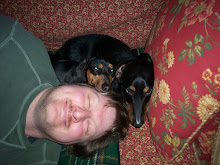The link posted here is to a map created using ERDAS IMAGINE 2010 software as part of the University of West Florida On-line GIS Certification program class, Photo Interpretation and Remote Sensing (GIS4035/L). The link requires Internet Explorer to open and display properly.
The image is a rectified Landsat ETM+ satellite image of downtown Pensacola, Florida. Rectification is the process of making an image conform to a specific known projection system by referencing map coordinates on the image to a known source set of coordinates from an existing map or other resource, a process called georeferencing. In the challenge assignment, students had to georeference locations in the satellite image to like locations from a USGS topographic reference map. The process requires locating similar features on both maps and using ERDAS Imagine's Multipoint Geometric Correction workspace to place Geographic Control Points (GCPs) on both maps that the software can use to determine how accurate the reference is. The software does so by calculating a type of error called the Root Mean Square Error(RMSE) for each of the points. The lower the error can be made for each point, the more accurate the re projection of the image is. In our case, we were required to place at least seven control points with a total average error below 1.0; essentially within 1 Pixel value in the satellite image. I placed eight control points on the map and had a total average RMSE of 0.255 and a Total Control Point Error value of 0.3034.
Landsat ETM Image of Downtown Pensacola
I thought this was a fun lab. It is similar to an exercise we did with ArcGIS in Intro to GIS last semester but the level of error required was much much lower. However, I found that it wasn't too difficult to lower your error values after some trial and error experimentation with the software. Basically, you need to place a point in an identifiable location in the topographic map, then place the same point in the image and check what the error is. Once you have the value, blow the image up to an extreme size where each pixel can be seen distinctly. At that point you can move your control point on the satellite image and using the on-the fly RMSE values that change with each move essentially home in on where the point should actually be located. I think with a little practice I could get my RMSE below 0.1 if needed.
Monday, July 12, 2010
Subscribe to:
Post Comments (Atom)

No comments:
Post a Comment